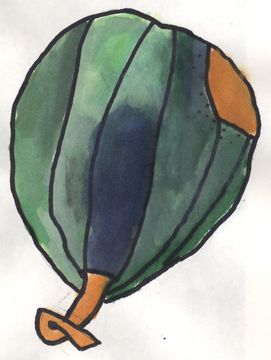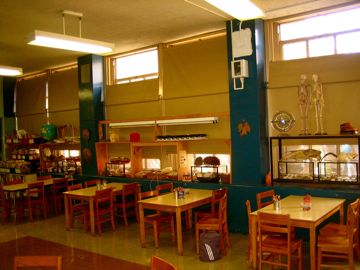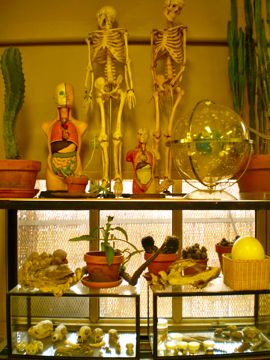A few weeks ago I had the pleasure of visiting The Earth School in New York’s East Village and at one point noticed a science classroom through a small window that immediately struck me- there were plants, bones, drawing materials, cabinets, books, field guides, lots of sunlight and carefully arranged tables and workstations. The room itself was like a beautiful business card for the teacher, Abbe Futterman, whom I’d never met. Anyone could tell this place meant business. There wasn’t a child in the classroom but you could clearly see that the students and their teacher took pride in the work that was accomplished here. After asking a few questions I was quickly introduced to Abbe and pleasantly surprised to find out that she is a Pratt Institute graduate who often teaches science through the arts. Below is a conversation we had following that visit.
JF: You work as a science teacher that graduated Pratt Institute. That alone is interesting. Tell me about that transition.
AF: It was more of the shift from art to the art of teaching because I began as a 3rd and 4th grade teacher. Only later did I become a science teacher. When I discovered how much creativity there is in teaching, it became my first love. I especially enjoy teaching science because it captures the imagination and wonder of the students and myself. Description and documentation are also very important to me and, I believe, for learning science. The processes of Audubon, Darwin, and McClintock have influenced how I view science. Teaching young people life drawing techniques gets them to slow down, observe, and notice the structure of things. Equally important to me is that my students experience what Eleanor Duckworth calls “the having of wonderful ideas,” which I interpret as the imaginative act of discovery and synthesis and which is very akin to a powerful aesthetic experience. I think these acts of the imagination empower and enlighten children and adults similarly.
JF: Can you describe some of the situations or lessons where you use drawing in your classroom? Are there particular artists that have made their way into your curriculum?
AF: I use drawing or scientific illustration in various ways with my students. For example, if they are studying biology using snails, or mealworms, or plants, or pillbugs, I have them do large detailed studies. I teach this technique starting in Kindergarten right through fifth grade- explicit life drawing techniques that I call “Looking and Drawing.” I model first using pencil and an art eraser. I implore them to look a LOT and draw a LITTLE; look a LOT and draw a little more; to erase as needed; and redraw. I emphasize the looking: “Is this plant the exact green that’s in the paint set?” “Is the entire plant the same green?” Then I show them some basic mixing and blending techniques. Students often draw and then label the parts. They get to draw microscopes, flowers, fruit, etc.
JF: You mentioned enjoying teaching science because it captures the wonder and imagination of both the students and yourself. I teach visual art for the same reason. Do you feel that teachers need to have a sense of wonder in order to teach effectively? If so, how do you keep that sense, that spark, alive in your own work?
AF: Children are by nature “wonder-igniters” since they live in the world of imagination and discovery. The hard part is listening well and not getting carried off completely by the day-to-day logistics of classroom life. I think teachers need to stay open to their students and to know each one well enough to be awed by him/her and his/her work. The opposite of that– not seeing/knowing the person, the individual– is what drains our positive energy from teaching.
JF: What does students becoming empowered through using their imagination look and sound like in your science classroom?
AF: Finding slug eggs, making the bulb light up, getting the microscope to focus, seeing cells for the first time, nurturing a seed, harvesting a tomato, catching the mealworm beetle as it “hatches” out of its pupa, making a “floater” sink and a “sinker” float, building a taller block building, getting a marble to run through a maze. Discovery that is the result of an imaginative act– one’s own “wonderful idea”– is a powerful thing. I believe that when children experience their own agency in this way, they learn that they can change the world.
JF: I noticed when visiting your school that you encourage learning inside and outside the classroom…. literally. Can you talk more about what your classroom setup is like?
AF: My science classroom consists of a large room with tables, a carpeted meeting area, and an extensive library. It houses a great collection of natural objects that are on display and available for the children to explore: giant pine cones, bones, rocks, shells, fossils, preserved specimens. It is well equipped with tools and equipment for science exploration and documentation: Microscopes, many kinds of scales, timers, measuring cups, art materials, junk boxes, etc. There are usually some tanks of living things: currently stick bugs, slugs, snails, pillbugs. We are also fortunate to have an outdoor annex as our school garden. It is entered by walking up a few stairs in the classroom and then through a large window. The garden is an organic edibles garden with about sixty planting barrels, a “free digging zone,” a compost pile, and storage sheds. It’s long and thin- about 10′ x 90′.
JF: Earlier you said, “I think teachers need to stay open to their students and to know each one well enough to be awed by him/her and his/her work..” How do you stay open? How has art helped you get to know your students better?
AF: Listening to kids and looking closely at their work without judging is a discipline that requires an open mind. Working in the current high-stakes testing environment, teachers tend to limit their observations by making quick judgments or interpretations. When a child makes something, it is their mark on the world for us to see. I think it is a very pure way of getting to know a young person. I’ve studied archives of a single child’s work over the span of a dozen years and been amazed at how much continuity there is. It’s still surprising to me that people start exploring themes and images from such a young age and keep returning to the ones that resonate.








Pingback: What’s Cookin at the Art21 Blog: A Weekly Index | Art21 Blog
Pingback: Thankful | Art21 Blog